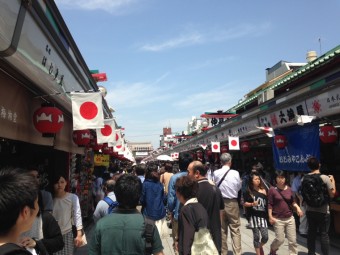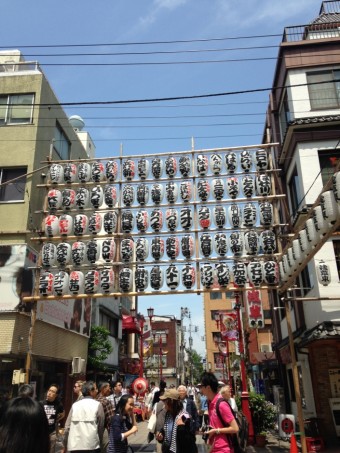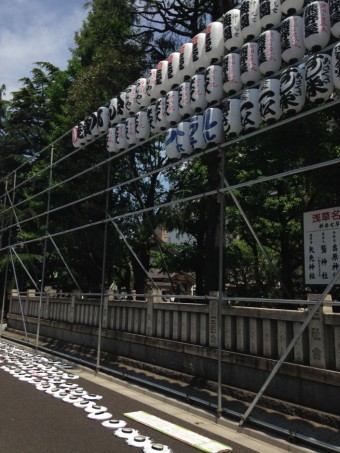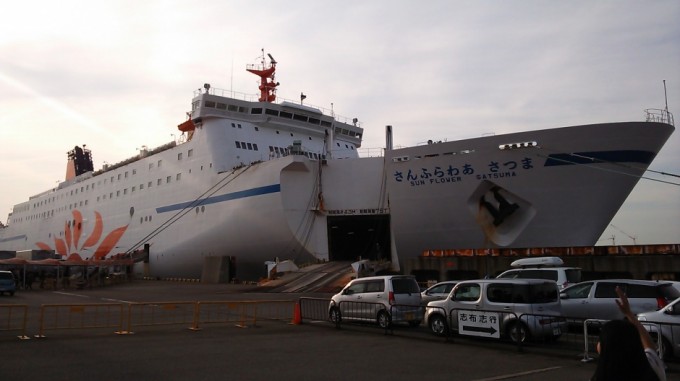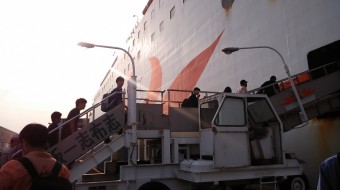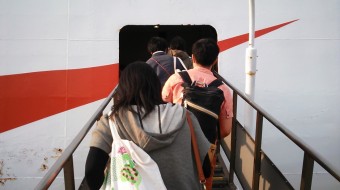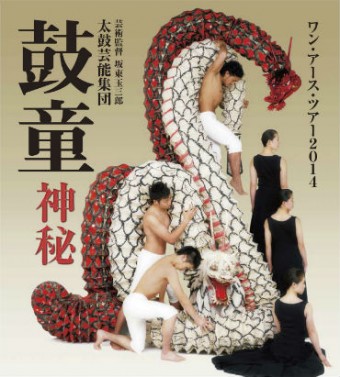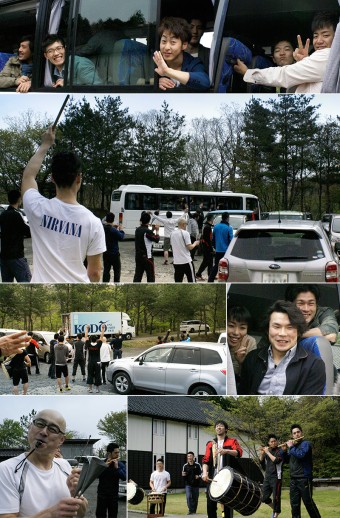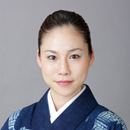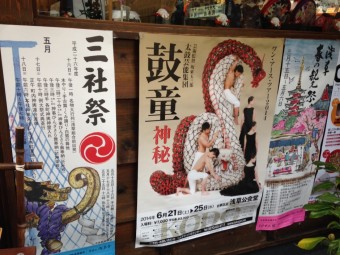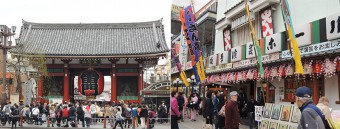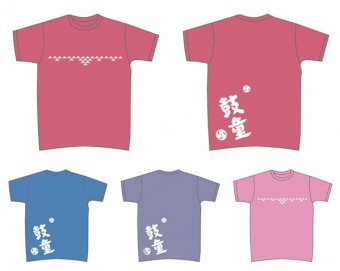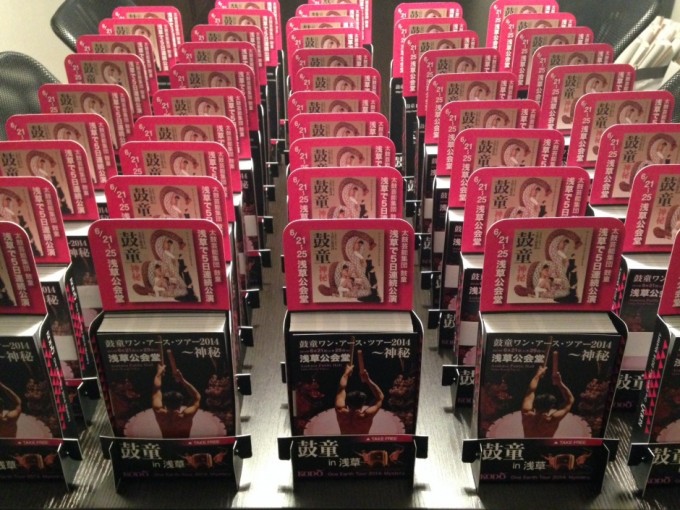Tag ‘Kodo One Earth Tour’
“From ‘Amaterasu’ to ‘Mystery’: Part 3″ by journalist Sachiko Tamashige
From “Amaterasu” to “Mystery”: Part 3
Article by journalist Sachiko Tamashige
Iwami Kagura: Feeling the Heat and Beat in Shimane Prefecture
Yosuke Kusa admires Taizo Kobayashi, his teacher of Iwami Kagura (Iwami: a region, the west part of Shimane Prefecture/ Kagura: dance and music for the kami, or deities): “Taizo looks so cool when he claps his hands to pray for deities in front of the household Shinto altar. Even his everyday routines show his integrity, which is also reflected in his Kagura performance. Kagura is not just about dancing — it is also the way a performer lives their life.” Yosuke met Taizo at the Kyoto University of Art and Design when Taizo ran an Iwami Kagura workshop. Around ten years ago, he started visiting Taizo in his hometown of Yunotsu, Shimane Prefecture.
Taizo’s primary job is making masks for Iwami Kagura. In September of 2013, two cast members of Jamai — Yosuke and Shogo Komatsuzaki — spent two weeks at Taizo’s studio to learn the serpent dance, as well as experience life with the local people. Yosuke and Shogo tried to get to the heart of the Kagura by visiting local shrines, going for runs in the surrounding nature and exchanging ideas and music techniques through sessions with members of a local group of Iwami Kagura. “The local people live with the deities by practicing rituals to either purify themselves or show their gratitude,” Yosuke added, “Iwami Kagura is nourished and enlivened by the way the locals live their lives, and it has been handed down from their ancestors to future generations. Iwami Kagura is also a way for adults to teach good behavior and adherence to the social code to their children. I would like to learn not only the forms and techniques but also its spirit, which links our lives with our direct experience on stage.”

Mr. Kobayashi makes masks at the Kobayashi Workshop.
An array of Kagura masks await their chance to spring into action.
“It’s Almost Time for Sanja Matsuri!” by Naomi Iseki
Asakusa in Tokyo is full of tourists during Golden Week, when there is a cluster of Japanese national holidays, and a lot of Japanese flags are hung along the main street, Nakamise-dori.
You can see lanterns everywhere for the festival “Sanja Matsuri,” which will take place really soon. I am very excited!
Lanterns are being put up along the streets around Asakusa Shrine. You can see some lanterns here on the road waiting to be hung.
“One Earth Tour Heads to Kyushu!” by Narumi Matsuda
On May 6, we boarded a ferry bound for Kyushu. We are used to seeing the Sea of Japan from the Sado ferry, so it was fun to see different seas during this 15-hour journey.
While we were waiting for the ferry, some of us really enjoyed a quiz game. Everyone was somewhat excited so this trip felt different than our usual bus travel!
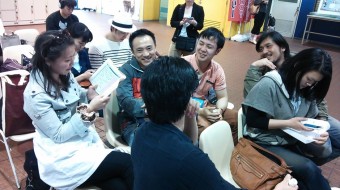
Kodo Performances in Kyushu!
We look forward to seeing you all there!
Kagoshima May 10 (Sat) Houzan Hall (Kagoshima Prefectural Culture Center) Start: 17:30/ Inquiries: Kagoshima Onkyo Tel. 099-226-3465
Miyazaki May 11 (Sun) Hyuga Bunka Koryu Center Start: 18:00/ Inquiries: Hyuga Bunka Koryu Center Tel. 0982-54-6111
Fukuoka May 13 (Tue) Fukuoka Symphony Hall Start: 18:30/ Inquiries: Picnic Ticket Center Tel. 050-3539-8330
“Setting Off on the Spring ‘Mystery’ Tour!” by Maya Minowa
We have just set off from Kodo Village on our Spring “Mystery” tour!
We will start our tour from Kagoshima, in Kyushu where I was born. I am so excited! We are looking forward to seeing you all, all over Japan!
“Posters in Asakusa” by Naomi Iseki
The posters you usually see in Asakusa are very unique: thin, narrow and illustrated. They are so creative and lovely. The other day, I found a Kodo poster in between a couple of festival posters when I was out and about.
“From ‘Amaterasu’ to ‘Mystery’: Part 2″ by journalist Sachiko Tamashige
From “Amaterasu” to “Mystery”: Part 2
Article by journalist Sachiko Tamashige
Behind the Scenes of “Mystery”
Jamai — the “Serpent Dance” — is derived from Orochi, known as “the Great Serpent Dance” from Iwami Kagura (Iwami: a region, the west part of Shimane Prefecture/ Kagura: dance and music for the kami, or deities).The Kodo cast members of Jamai absorbed the skill and spirit of this traditional folk dance by learning from local performers while in Shimane as artists in residence. Iwami is the name of this area in the western part of Shimane Prefecture. Iwami is famous for its historical site, Iwami Ginzan, the largest silver mine in Japan, a world heritage site. Kagura was originally performed to summon kami (deities) during traditional rituals of worship in shrines and other sacred places. Japanese traditional music, dance and festival culture has its roots in these ancient rituals. Taiko, or the Japanese traditional drum, was once regarded as a sacred instrument because of its magical power to conjure up the deities for tasks such as bringing rain to a region in need.

The Kodo cast members of Jamai absorbed the skill and spirit of this traditional folk dance by learning from local performers while in Shimane as artists in residence.
“Come to See Kodo in Asakusa!” by Nobuyuki Nishimura
Come to see Kodo in Asakusa!
Photos: Takashi Okamoto, Taro Nishita and Naomi Iseki
Asakusa is in a part of Tokyo called “shitamachi,” which is the traditional shopping, entertainment and residential district of Tokyo. It is an area where the atmosphere of the past decades of Tokyo is still alive and well. We had performances at Asakusa Public Hall last year and we have been given the chance to perform here again this year, too!
A year has passed since I personally became based in Asakusa. I was lucky enough to help carry a mikoshi (portable shrine) during Asakusa’s famous festival, “Sanja Matsuri.” People in Asakusa think about this festival all year long and the whole town sparkles when the time for the festival itself draws near.
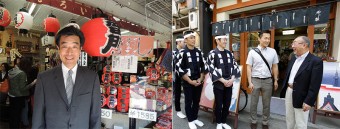
Left: Mr. Fuji, President of Asakusa Tourism Association
Right: Vice President Mr. Kawakami with some Kodo members and I in front of his shop (2013)
“From ‘Amaterasu’ to ‘Mystery’: Part 1″ by journalist Sachiko Tamashige
From “Amaterasu” to “Mystery”: Part 1
Article by journalist Sachiko Tamashige
Guided by the Mysterious Power of the Serpent
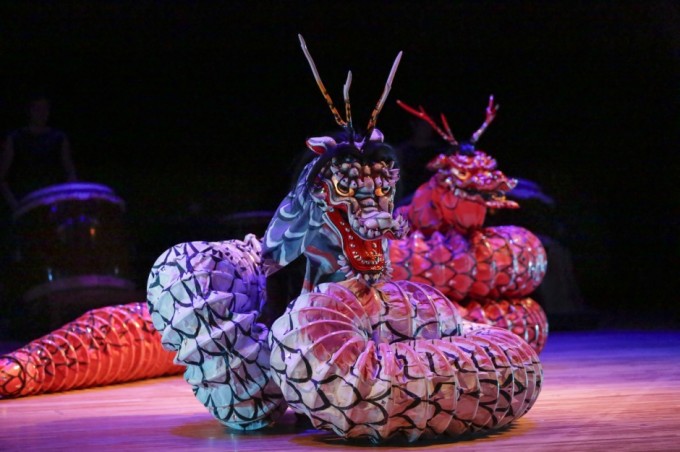
Jamai
Aside from the dim outline of a mountain, the stage is shrouded in darkness. Look closely, and you may catch a glimpse of something undulating in the distance, then out of the black they appear: three giant snakes, entangled with each other. As they gradually reveal themselves, it becomes clear that a spectacular and ominous world awaits. Three snakes wriggle free from each other, their scales glinting in the dim light. The sound of the taiko takes on the cadence of a heartbeat as an eerie melody is played on a Nohkan, the bamboo flute used in Noh and Kabuki theater. Your invitation into a mysterious realm is complete. The snakes return to the darkness while the lights of lanterns float in the air like giant fireflies. Like an ancient lullaby, voices arise, transporting you to forgotten childhood memories.
Where exactly are we? Each of you might ask yourself this question in the darkness. Kodo’s unique sound and spectacle have the ability to transcend the reality around you.
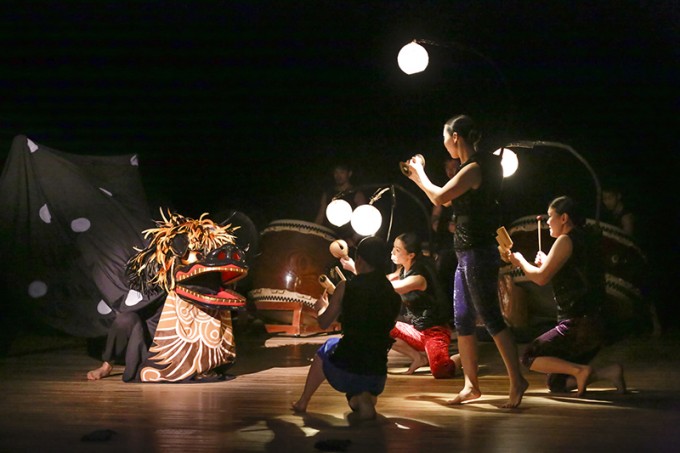
Shishimai
In the autumn of 2013 — the year of the serpent — the brand new production, “Kodo One Earth Tour: Mystery” was revealed with this mesmerizing opening scene. Directed by Tamasaburo Bando and premiering on Sado Island, Kodo’s home and base of operations, Mystery consists of 18 scenes, including ones inspired by traditional folk dances such as Jamai, Namahage and Shishimai, and contains scenes newly created by members of Kodo such as Yomichi and Yuyami, along with pieces from the classic Kodo repertoire.
Kodo “Mystery” Tour T-shirts in New Spring Colors!
We are happy to announce our new Kodo Mystery tour t-shirts in spring colors. They are made of tri-blend fabric and available in four colors: vintage heather blue, purple, pink and red. The triangular uroko design and Kodo calligraphy (the same as seen on the lanterns we use on stage) are printed in white.
Kodo “Mystery” T-shirts in blue, purple, pink and red
http://www.kodo.or.jp/store/38.html
For orders in English, please contact the Kodo Online Store by email. Email: store.eng@kodo.or.jp
Kodo Online Store
http://kodo.shop.multilingualcart.com/
“Spreading the Word About the Upcoming Asakusa Concerts” by Naomi Iseki
The “Kodo One Earth Tour 2014: Mystery” Asakusa Performance postcards are ready to be distributed!
These advertising postcards will be placed on shop counters throughout Asakusa soon.
We hope that many people will pick them up, spread the word, and come along!
“Kodo One Earth Tour 2014: Mystery” Performances in Asakusa, Tokyo (June 21-25)
http://www.kodo.or.jp/oet/index_en.html#schedule05a




